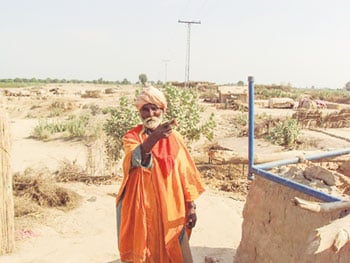BIODIVERSITY
 It might be the first generation of snake charmers, one of the largest gypsy tribes of Sindh, whose children have decided to change their lifestyle from dealing with venomous snakes to studying in educational institutes.
It might be the first generation of snake charmers, one of the largest gypsy tribes of Sindh, whose children have decided to change their lifestyle from dealing with venomous snakes to studying in educational institutes.
These gypsy communities have almost lost their traditional routes, mountainous terrains, plain lands, thick forests, and deserts. Effects of climate change, development infrastructure, and the changing mindset of host communities on their year-long routes might have contributed to this shift in the cultures of the wandering people.
They have settled in organised colonies and are now motivating their children to join educational institutes instead of chasing behind cobras.
Misri Jogi, a chieftain of snake charmers tribe, residing in Jogi Colony Umerkot city, said, “Our children intend to move to schools. Many of them are studying in secondary schools. But it seems the government authorities are yet to recognise us as law-abiding citizens, and to provide us opportunities so our youth can learn skills and do jobs so they may enjoy mainstream life like others.”
Misri Jogi claims to have spent around 45 years out of his 65 years of life chasing cobras and dealing with all dangerous venomous snakes. Well known as an artist playing flute, elder Jogi accredits the government for offering a safe place of around 18 acres to the snake charmers in early 70s, where more than 100 families have been settled safely.
The other settlement is located nearby, where around 1,000 households live together. But the problem they face is the unavailability of an alternate source of livelihood for youth. A majority of them sit just idle at homes without any work, except treating their snakes.
It is a centuries-old practice that almost all households have their cobras and children deal with reptiles through inherited skills.
Misri Jogi has travelled to many countries with performing cobras to show skills with healing powers to treat people, who had falled prey to snake bites. He is an inspirational personality not only for their own community youth, but also for nature conservationists and government officials. His skill of dealing with cobras, playing the rhythmic flute, and healing people with herbal techniques has attracted many over the years.
Speaking of habitat loss and destruction due to climate change and rapid development, he said, “Recently, we travelled to the Kirthar Mountain Range in search of a cobra for its healing stone. The cobra is now rare to find, and the whole community has to travel long distances to find one.”
Typically, a cobra, despite being venomous, is known as a performing animal, dancing at the rhythmic tune of a murli (flute). Snake charmers believe it has cultural and inspirational value, having a precious healing stone on its head and ability to entertain children in streets in urban and rural villages.
Presently, cobra population has shrunk due to many reasons and experts believe if it goes extinct, the food chain will be devastated.
Snakes are expanding habitats in Sindh, as these ecologically important animals are facing threats due to habitat loss, excess use of pesticides in farmlands, reckless killing, increasing urbanisation, illegal poaching due to its skin trade, and climate change.
 The recent observations by officials of Zoological Survey Department of Pakistan (ZSDP) revealed scattered trails of snake species in Dadu and Thatta districts.
The recent observations by officials of Zoological Survey Department of Pakistan (ZSDP) revealed scattered trails of snake species in Dadu and Thatta districts.
"But what we have observed shows that cobra, kraits and vipers still exist near water bodies, like canals, lakes, and ponds. It requires specific survey for all snake species to ascertain the exact status of population and initiate conservation planning to save these important creatures," said Naseem Fakhri of the ZSDP.
Fakhri has wide experience of surveying wildlife species. "Recently, we initiated a general survey in different ecological zones of Sindh and observed scattered visibility of some species, including cobra, kraits, pythons, and vipers,” he said.
The wildlife officer said there was a need for a specific survey now. "On the basis of these (general survey) findings we believe a specific survey is needed to know all the venomous and non-venomous snakes," he added.
The ZSDP officer said cobra was sighted in remote areas in Dadu, Thatta and other parts of irrigated areas. However, it is under threat due to excess use of pesticides in crops, use of machinery in agriculture, urbanisation, and development of road infrastructures, which have damaged entire colonies of these worldwide threatened snakes.
According to the officer, even snake charmers are a threat to these snakes. “People approach them (snake charmers) to buy cobras for their poison. They usually catch it from the wild and use for performing and then sell it for its precious hide,” Fakhri alleged.
While the Sindh Wildlife Department has imposed a ban on poaching, killing and sale of these snakes because of their vulnerability and decreasing population, certain people are still involved in catching rare snakes, Fakhri said.
There were many shops and manufacturers in Karachi and other urban centres a few years back, which used skins of snakes to make bags, purses, shoes etc. It used to encourage snake charmers to catch snakes from natural habitats and earn a little extra. But following CITES (the Convention on International Trade in Endangered Species of Wild Fauna and Flora) the government has declared areas protective to avoid poaching of these threatened species.
Researchers believe that usually these creeping animals are needed to limit overpopulation of their prey such as rats, mice, bugs, etc, which are also a threat to human health. There would be a problem if the population of prey grows without limitations placed by snake predation.
Earlier, a unique Snake Research Laboratory was developed by self-claimed king of cobra late Faqeer Urs Behrani with his fellow snake charmers, wishing to promote conservation of all snake species in the province. For this, they had planned to establish a larger cobra farm at any government land but all went in vain.
However, sons of Faqeer Urs Behrani, after two years of his death have taken an initiative to revive the small cobra farm at their village Haji Gul Muhammad Behrani, located near Tando Allahyar city, where rare venomous species, including cobra have been kept with care for breeding. It is a ray of hope for nature conservationists and those who love wildlife. But it is up to government institutions and public universities' zoology departments, as these young men need support at all levels for extending this initiative.
Pakistan has around 67 snake species, venomous and non-venomous, inhabiting all its ecological zones, including land and sea- coastline, desert, mountainous and agriculture area.
There is a need to maintain this biodiversity.
The writer is a staff member